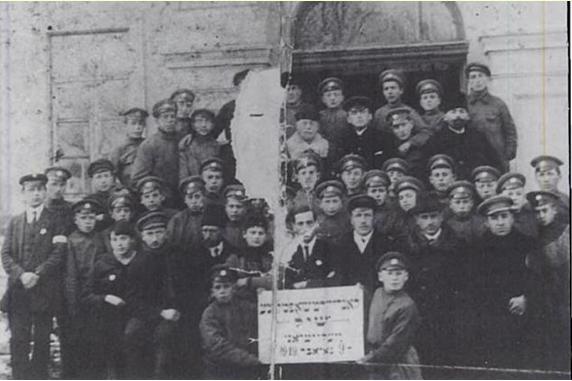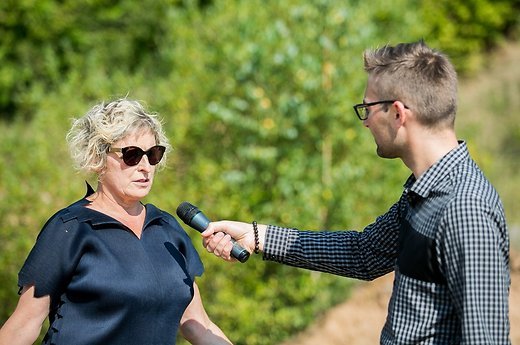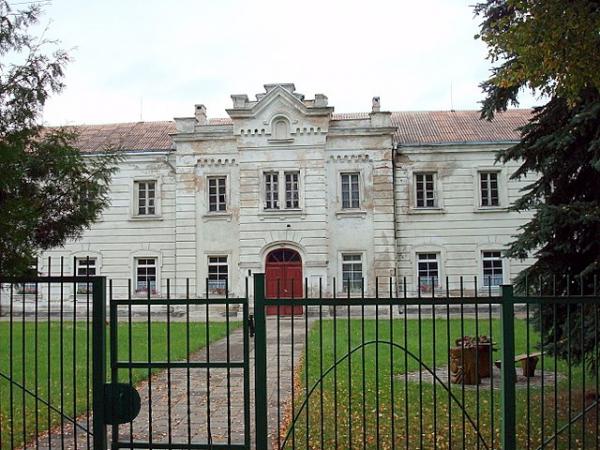
Simon Wiesenthal director and author Efraim Zuroff and Lithuanian author Rūta Vanagaitė are inviting Lithuanians to mark the Day of Remembrance of the Genocide of the Jews in Lithuania on September 23 this year by looking up the mass murder site closest to the their homes and making the trek there to light a candle and perhaps leave a small stone at the grave, a Jewish tradition.
Zuroff and Vanagaitė are focusing commemoration efforts on the town of Vėliučionys, a mass murder site about 12 kilometers outside Vilnius.
Efraim Zuroff:
This coming Friday, Lithuania commemorates the Holocaust, and Rūta Vanagaitė and I have launched a special initiative entitled “Čia guli Musiškiai” (Our People Lie Buried Here) to encourage Lithuanians to visit the mass grave of Shoa victims nearest their home. In all, there are 227 recognized mass graves in Lithuania, documented in the Lithuanian Holocaust Atlas, which is available online.
We are encouraging residents of Vilna/Vilnius to visit one of the most neglected mass graves near the city at a place called Vėliučionys, where 1,159 Jewish men, women and children were murdered by Lithuanian auxiliary police and a special mass murder squad on September 21 and 22, 1941. There will be a brief ceremony at 5 PM as we march from the manor where they were confined to the site of their murder.
Below is the story of the massacre based on testimonies from the Vilnius Special Archives, which has the files of the postwar investigations and trials of Lithuanian Nazi war criminals.
This account is based on the testimonies of the participants in the mass murder and of witnesses who were living nearby (Lithuanian Special Archive, the case of Vincas Sausaitis). In the middle of September, 1941, in the wake of an order issued by Lithuanian police chief Vytautas Reivytis, the arrest of all the Jews living in Naujoji Vilnia, Rudamina, Sumsk and other nearby towns started. The arrests continued for an entire week, during which the Jews arrested were brought to a children’s home in the former manor in Vėliučionys. By the last night of the arrests, over a thousand people were being held in the yard of the manor. Their belongings were piled up there as well.
The administrative chief of one of the local villages, Vincent Dowgiallo, ordered six local men to go to nearby Bald Mountain, some two kilometers from Veliučionys, and dig a pit. The men took their shovels and went to the place as ordered, but Dowgiallo did not come, so they sat down on the grass and started playing cards. Then a car appeared and a Geman officer told all six men to go home.
On the next day, a group of Jews was brought from the Naujoji Vilnia ghetto and were ordered to dig a pit “for storing potatoes.” In the afternoon of September 21, a sunny day, members of the Second Auxiliary Police Battalion were gathered in the Naujoji Vilnia barracks, and told by Captain Mešlius that an order to guard some Jews had been issued. So the soldiers marched to the Bald Mountain near Vėliučionys and surrounded the territory. They were told not to allow anybody to escape. In the meantime, a bus with some 30 to 40 men in civilian clothes arrived at
the site. They were the members of the “Ypatingas burys” (the Special Squad), among them Vincas Sausaitis, Captain Balys Norvaiša, Vladas Korsakas, a student of the Vilnius Music Conservatory, and one seventeen year old boy.
The Jews were told to leave their belongings in the yard of the colony and to start marching to the Bald Mountain where they were going to be put to work. Those who could not walk were put on wagons. Once at the pits, the Jews were ordered to undress, and all the men were asked to pull down their underpants and keep them in their hands at knee level.
All the Jews were ordered to lie with their faces down. Then, with their guns, the Lithuanian soldiers pointed to 10-15 people at a time, who had to get up and go to the edge of the pit. There they were shot by members of the “Special Squad” who were standing some 10 meters from the away. Apparently, the children were not shot, and instead had their heads smashed with rifle butts. Those in the pit who were initially only wounded, were shot by Captain Mešlius. Some of the Jews managed to escape, but they were caught in the fields, shot dead and left there.
In the middle of shooting, Captain Mešlius asked the guards who would be willing to shoot. According to the testimonies, Kupstas, Šermukšnis, Stulginskas, Vyšniauskas, Kinsleris, Kasparavičius and some others volunteered. There was vodka on the site, but only those who were shooting were allowed to drink.
In the evening, the shooting was over, but nobody covered the corpses. All the soldiers ate their dinner at the site. Special squad members went to Dowgiallo’s house and had dinner there, and some more vodka was bought for them. The soldiers of the Second Auxiliary Police Battalion returned to Naujoji Vilnia for the night. The Special Squad members went back to Vilnius by bus.
On the next day, all of them came back and the massacre continued. By the afternoon, all the Jews were shot dead. According to the summary report on the murders in Lithuania compiled by German officer Karl Jäger, a total of 1,159 victims were murdered at Vėliučionys on September 21-22, 1941, among them 468 men, 495 women and 196 children.
In June 1944, a special German unit surrounded the territory again and started burning the corpses. For two days, the smell of the burning bodies was felt by the people living in the nearby houses. In 1951 a small monument was built. There is no marker to direct people to the site.

photo courtesty DELFI.lt
Rūta Vanagaitė:
Civic initative
Our People Lie Buried Here
5:00 P.M., Friday, September 23, 2016, across Lithuania
Seventy-five years ago in 1941 the mass murder of the Jews was committed in Lithuania: 200,000 Lithuanian Jews were murdered. Most of them were murdered over several months that autumn, and, sadly, thousands of our people were perpetrators.
There are 227 mass murder sites in the forests of Lithuania. All of those black stains upon our history and geography were recently documented in the Lithuanian Holocaust Atlas, www.holocaustatlas.lt. So now each of us can find out at the press of a button what happened then near our homes.
Do you know those mass murder sites? Have you ever turned off the road and visited one of those forest clearings or bushlands where just a few layers down in the ground the bones of thousands of Jews, our grandparents’ neighbors, still lie, and the bones of the children whose heads were smashed on a tree just so the murderers could save ammunition?
Some mass graves in Lithuanian forests and bushlands are marked, there are monuments there, but the majority are difficult to find and abandoned, with ruined monuments or none at all.
Every year the Day of Remembrance of Jewish Victims of Genocide in Lithuania is observed here. This year we mark the 75th anniversary of the beginning of these large-scale massacres. On that day we are asking each Lithuanian citizen who cares to visit at least one abandoned mass grave, to light a candle and to say to him or herself and their family and all of Lithuania five simple words: “Our people lie buried here.”
The initiative is being organized via social networks to take place across Lithuania at 5:00 P.M. on September 23.
Rūta Vanagaitė, organizer
Our People Lie Buried Here initiative
Background:
Killing in Veliucionys, September 21-22, 1941
(Testimonies of the participants of mass murder and witnesses living nearby (Lithuanian Special Archive, Vincas Sausaitis case)
In the middle of September, 1941, under the order of Lithuanian Police chief Vytautas Reivytis arrest of the Jews living in Naujoji Vilnia, Rudamina, Sumsk and other nearby towns started. The arrests continued the whole week. Arrested Jews with were brought to a children’s colony in the former manor in Vėliučionys. The last night over a thousand people were held in the yard of the colony. Their belongings were piled up there as well.
The administrative chief of a local village Vincent Dowgiallo ordered six local men to go to the Bald mountain some two kilometers from Veliucionys and to dig a pit. These men took their shovels and went to the place as ordered but Dowgiallo did not come so men sat down on the grass and started playing cards. Then the car appeared and a German officer told all six men to go home.
The next day a group of Jews were brought from Naujoji Vilnia ghetto. They were ordered to dig a pit “for storing potatoes.”
In the afternoon of a sunny day, September 21st, members of the 2nd defense battalion were gathered in Naujoji Vilnia. They were told by a captain Mešlius that the order to guard some Jews was issued. So the soldiers marched to the Bald Mountain near Vėliučionys and surrounded the territory. They were told not to allow anybody to escape.
The bus with some 30 to 40 men in civil clothes arrived to the site. They were members of the Special Squad, among them Vincas Sausaitis, captain Balys Norvaiša, student of Vilnius Music Conservatory Vladas Korsakas and one seventeen-year-old boy.
The Jews were asked to leave their belongings in the yard of the colony and start marching to the Bold mountain. They were told that they were taken to work there. Those who could not walk were put into the carriages. Once at the pits the Jews were told to undress. All men were asked to pull down their underpants and keep them with their hands at the knee level.
All the Jews were asked to lie with their faces down. Then the soldiers pointed out with their guns 10-15 people at a time to get up and go to the edge of the pit. Then Special Squad members who were standing some 10 meters from the pit shot them. Apparently children were not shot but their heads smashed with a rifle buts. Those who were not killed but wounded in the pit were shot by captain Mešlius. Some of the Jews managed to escape, but they were caught in the fields, shot dead and left there.
In the middle of shooting captain Mešlius asked the guards who would be willing to shoot. According to the testimonies, Kupstas, Šermukšnis, Stulginskas, Vyšniauskas, Kinsleris, Kasparavičius and some others volunteered. There was vodka on the site but only those who were shooting were allowed to drink.
In the evening the shooting ended, but nobody covered the corpses. All the soldiers ate their dinner at the site. Special squad members went to Dowgiallo’s house and had dinner there, also some more vodka was bought for them. Soldiers of the battalion returned to Naujoji Vilnia for the night. The Special Squad members went back to Vilnius with the bus.
The next day all of them came back and the massacre continued. By the afternoon all the Jews were shot dead. According to the Karl Jäger report, there were 1159 victims altogether; among them 468 men, 495 women and 196 children.
In June 1944 German soldiers surrounded the territory again and started burning the corpses. For two days the smell of the burning bodies was felt by the people living in the nearby houses.
In 1951 a small monument was built. There is no sign for those wishing to visit the site.

We will gather at the former Vėliučionys prison colony building (formerly the manor, now the Children’s Socialization Center) at 5:00 P.M. on September 23 to mark the 75th anniversary of the mass murder. From there we will follow the route they took to Bald Mountain, the mass murder site. Please bring a candle and a small stone.
The town of Vėliučionys is 12 kilometers from Vilnius on the Šumskas highway.

